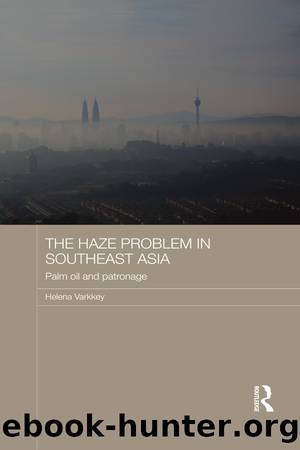The Haze Problem in Southeast Asia by Helena Varkkey

Author:Helena Varkkey [Helena Varkkey]
Language: eng
Format: epub
ISBN: 9781317511106
Publisher: Routledge
Patronage relationships are âamorphous, latent, elusive, and ubiquitousâ (Scott, 1972: 92â113). As an extension of the simple dyadic patronage link, patronage politics refers to the overall pattern of patronage linkages joining the actors in a given area or community (Scott, 1972: 92â113).
Patrons and clients are almost exclusively motivated by material gain (Kurer, 1996: 645â661). In this way, patronage politics can be seen as âa form of domination that is used by modern political and economic elites to channel resources for their own benefitâ (Gunes-Ayata, 1994: 17â26). This is why they are usually regarded as disreputable, if not illegal, by parties external to this relationship (Eisenstadt and Roniger, 1995: 209â233).
According to Kurer (1996: 645â661), âpatrons and clients have an interest in replacing collective with private goods, and one way of accomplishing this is to override bureaucratic procedures and allocate resources not according to bureaucratic norms (or set policies) but on the basis of political interestâ. An important contemporary resource base available to a potential patron is indirect, office-based property (Scott, 1972: 92â113). This involves office holders who hold discretionary powers over scarce values such as employment, promotion, assistance, welfare, licensing and permits (Scott, 1972: 92â113). For example, an office-holding patron can offer privileges to property rights to generate economic rent, or income-earning opportunities such as licenses to generate an income above opportunity costs (Kurer, 1996: 645â661). This is illustrated clearly later in this chapter, where well-connected plantation companies in Indonesia are able to obtain privileged rights to choice parcels of land for development of oil palm plantations (Rukmantara [I45], 2011; Suwarsono [I3], 2010; Tarigan [I23], 2010,), despite contrary laws and policies that exist. It is this combination of potentially open access to markets with the continuous semi-institutionalized attempts to limit free access that is the crux of the patronage politics model (Eisenstadt and Roniger, 1995: 209â233).
An excellent way for a political leader to stay in power is to ensure that he is always surrounded by loyal followers. Hence, he may calculate that some inefficiency in the system is a small price to pay for said loyalty. Patronage âallows leaders to build a team of public managers who share the leadersâ policy agenda and who can be trusted not to sabotage or delay important programsâ (Brinkerhoff and Goldsmith, 2004: 163â182). In such conditions, there often arise situations of âmutual hostageâ relations, which Enderwick (2005: 129) describes as situations âwhere the principal partners (politicians and business leaders) become locked into a situation of mutual dependency, where change by one threatens the well-being of the otherâ. Such mutual hostage relations severely restricts state capacity to create or uphold effective policies, as powerful patrons in the government or administration are locked into making policy choices that reflect the interests of their client, with little consideration of the interests of the society at large.
One of the main things that differentiate patronage politics from a one-off bribe is the ongoing nature of the relationship. Patronage politics is essentially a reiterated interaction, with each side making decisions about their behaviour today in the anticipation of future interactions.
Download
This site does not store any files on its server. We only index and link to content provided by other sites. Please contact the content providers to delete copyright contents if any and email us, we'll remove relevant links or contents immediately.
| Africa | Americas |
| Arctic & Antarctica | Asia |
| Australia & Oceania | Europe |
| Middle East | Russia |
| United States | World |
| Ancient Civilizations | Military |
| Historical Study & Educational Resources |
The Story of China by Michael Wood(928)
Mr. Selden's Map of China by Timothy Brook(775)
Philippines--Culture Smart! by Culture Smart!(669)
Heroic Hindu Resistance To Muslim Invaders (636 AD to 1206 AD) by Sita Ram Goel(655)
Akbar: The Great Mughal by Ira Mukhoty(651)
The Meaning of India by Raja Rao(631)
Vedic Physics: Scientific Origin of Hinduism by Raja Ram Mohan Roy(624)
Food of India by unknow(618)
Banaras by Diana L. Eck(614)
India--Culture Smart! by Becky Stephen(602)
First Platoon by Annie Jacobsen(601)
China Unbound by Joanna Chiu(601)
Mao's Great Famine: The History of China's Most Devastating Catastrophe, 1958-1962 by Frank Dikötter(594)
North of South by Shiva Naipaul(590)
Insurgency and Counterinsurgency by Jeremy Black(564)
How to Be a Modern Samurai by Antony Cummins(563)
The Genius of China: 3,000 Years of Science, Discovery, and Invention by Robert Temple(562)
A History of Japan by R.H.P. Mason & J.G. Caiger(561)
The Digital Silk Road by Jonathan E. Hillman(550)
